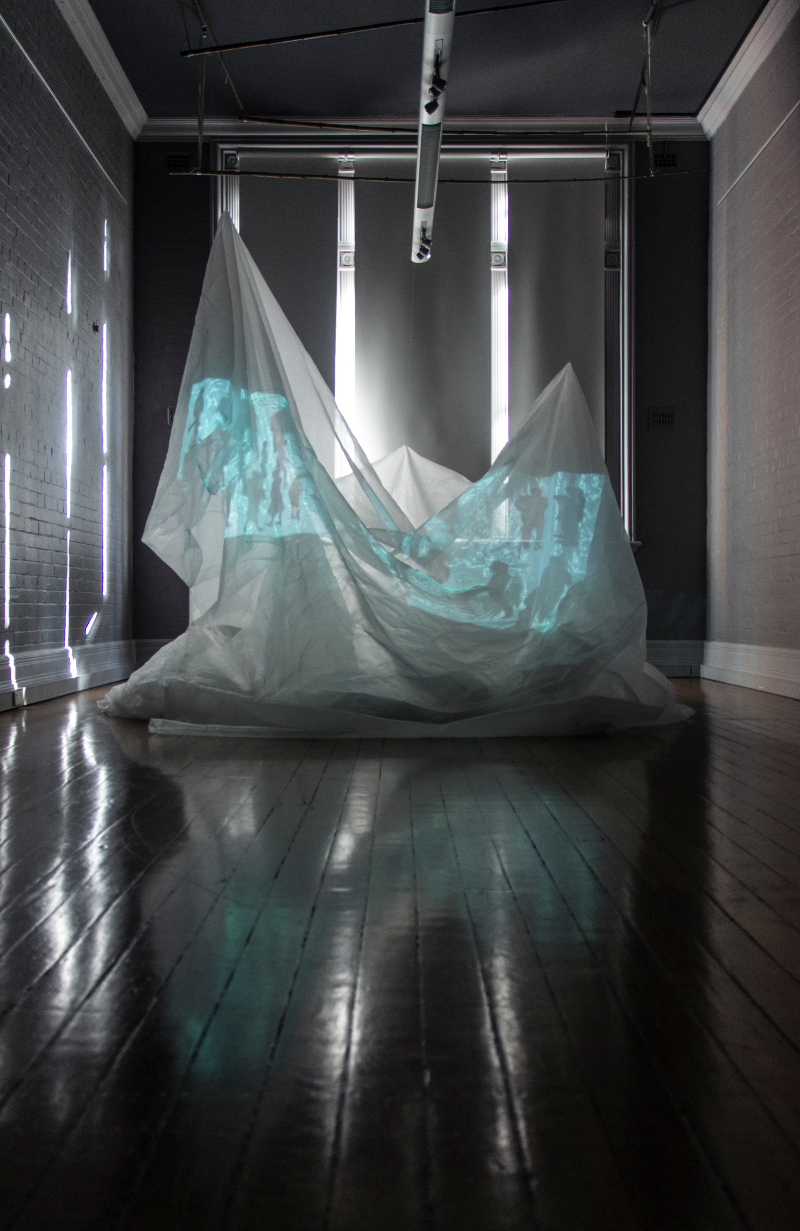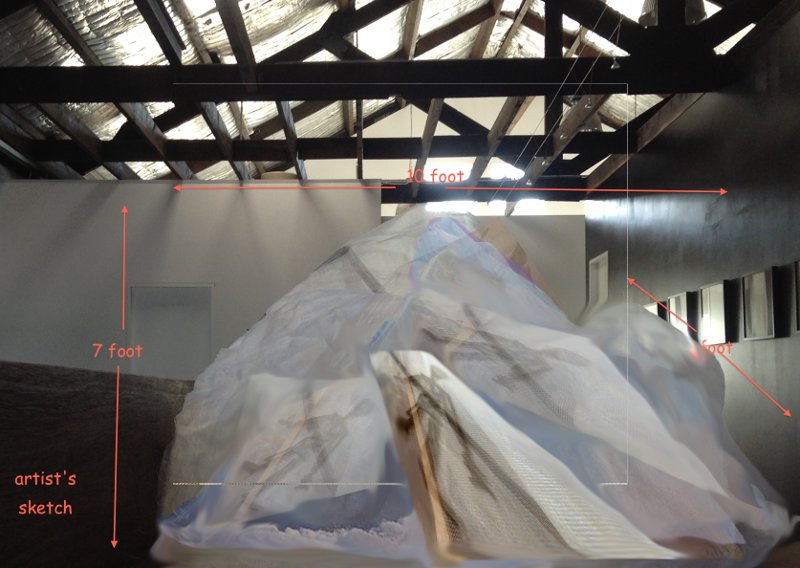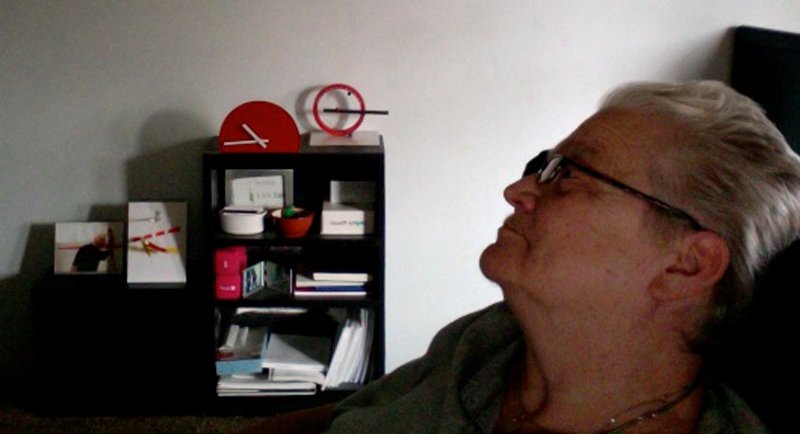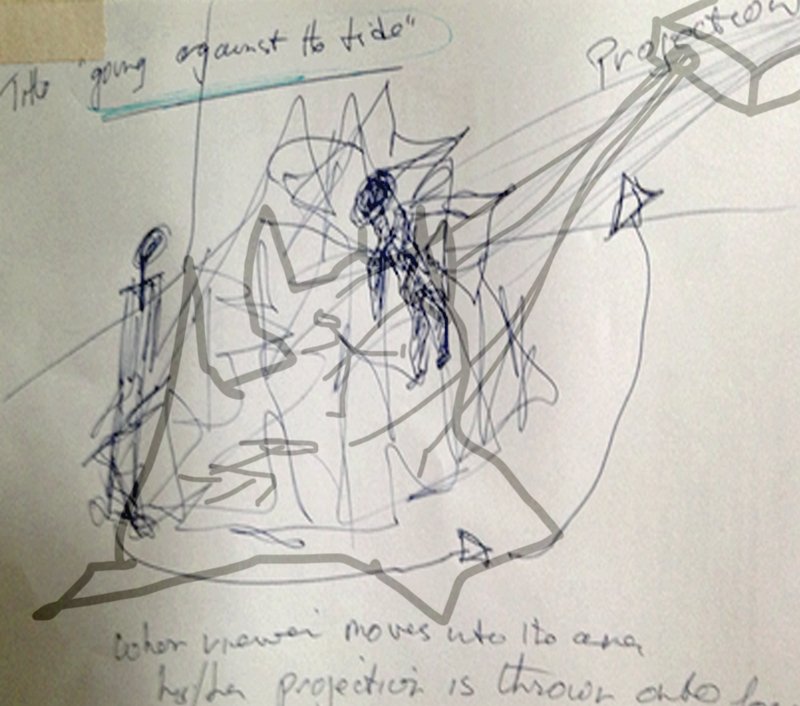Living Data
Science Art & Talks
The experiential process of observation and reflection is key to art and science
and is an essential component in understanding interdependence
of all species and ecosystems, terrestrial and aquatic.
Paul Fletcher Animator
Science Art & Talks
Living Data Program for the 2013 Ultimo Science Festival, Sydney, September 12-21.
Going Against the Tide Video installation by Rose McGreevy
It is a scary thought that the planet is reacting negatively to our behaviours. An art work offers a quiet, safe place to engage with climate change.

Going against the tide
Video installation by Rose McGreevy
Photo: Stephen Pierce

Going against the tide
Concept design by Rose McGreevy
This work offers the opportunity to reflect and engage on a poetic and maybe subliminal level to notions of interdependance between humans and the earth.
Dr. Jianli Chen's examination of glaciers, ice sheets and the polar regions in general have been influencial in this work. As a geo-physisist, he has been studying these areas and recording his findings in publicationsfor many years but the paper: Chen, J.L., C.R. Wilson, B.D. Tapley, Contribution of ice sheet and mountain glacier melt to recent sea level rise, Nature Geoscience, DOI: 10.1038/NGEO1829, 2013 (in press), really got me thinking. According to this paper the ice is melting faster each year which can mean water levels rise, animals like the polar bear will become extinct, land masses will be gone which, to me, means less land for an already over-populated world. With less land and more people, I feel, there will be more stavation, more wars. The quality of life we now enjoy will be gone and all because we (the majority) didn't pay attention or didn't want to know what is happening to the earth. This work 'going against the tide' which I hope is more seductive than my writing, will maybe, give people the opportunity to reflect and engage on a poetic and maybe subliminal level to notions of interdependance between humans and the earth. It is a scary thought that the planet is reacting negatively to our behaviours and sometimes, we need a quiet, safe place to engage.
I gained a Bachelor of Arts with Honours at the University of Ulster and a Master of Arts in Sculpture at the Chelsea School of Art in London. I completed a Fellowship at Sydney College of the Arts in early 80's and went on to live and work as an artist in New York. I returned to London in the mid 1980's where I was a permanent part-time lecturerer at the Royal College of Art, Chelsea School of Art and Middlesex Polytechnic. In 1995 I returned to live in Australia where I was a lecturer in Sculpture at the College of Fine Arts at the University of New South Wales.
Rose McGreevyJune 2013

Rose McGreevy
Recent exhibitions:
2013
'R G B' Museum of Modern Art, NYC;
'Abstract Currents: An interactive video event, Ladg Los Angelos group show
2012
factory49@the rocks pop up, Sydney
factory49 small gallery showroom, Sydney
Articulate ProjectSpace, site/non-site, Sydney, curator Elizabeth Day
2011
Drufabriek Cultural Centre, Ulft, Netherlands
Delmar Gallery, Sydney
Articulate Project Space, Sydney
2010
Articulate Project Space, Sydney
Intimacy Delmar Gallery, Sydney
LA Digital Art Gallery group show, Los Angelos, USA
factory 49 outdoor work, Sydney
factory 49, Sydney: Dangerously Safe
2009
factory 49 Showroom,Sydney
non-identical sets, Level 17 Victoria University, Melbourne
The colour of space, Bell Street Project Space, Vienna, Austria
Delmar Gallery, Sydney
Notes for exhibition designers:
A model is being built to show visually and at a subcomscious level the interaction and dependance that we as humans have with nature. And that whilst it is a beautiful thing it is also a fragile thing. An installation of a 3dimensional glacier-like form is being made from biomesh and wood, roughly 10 foot long 4 foot wide and 7' tall with a film projected onto it of the silhouettes of people moving across it. There will be two/three small blue lights within the form creating a bluish mysterious aura. The light in the place where the work will be installed will be subdued. People will 'come across the work' and as they pass through and around the work - the way the film is projected - will also project their silhouette onto the form.

Concept drawing by Rose McGreevy
for her installation
Going against the tide
To evaluate how reciprocity works in Living Data and how our program could be improved, I ask contributors,
What do you most value about our work?
What have you contributed?
How have you benefited?
How could our program be improved?
Rose McGreevey, Artist, Australia
What do you most value about our work?
The diversity of creativity from the artists dealing with their
concerns about climate change. Seeing visual responses which included
topographical data allowed the subject matter to be engaged with in a
visceral manner.
What have you contributed?
An installation attempting to show the interconnectedness of human
beings and this ball spinning in space.
How have you benefited?
I find myself pondering on some of the works and thinking what a sad
and dangerous thing it would be if we - the human race - let this
wonderful multifarious world become vulnerable to extinction and as a
result am much more diligent about recycling and thinking about the
cost - in ecological terms - of the processes I use in my art work and
my life.
How could the Living Data program be improved?
Perhaps if one artist worked in tandem with a scientist over the
period of 6 months and displayed their results in the Muse with the
other artists. Frankly that is the only improvement I can think of because the show
was curated and accomplished perfectly.











